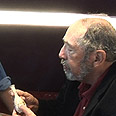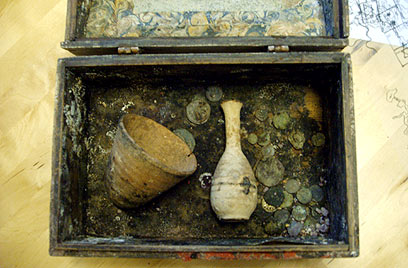
Jerusalem artifacts to star in new film
Based on archeological findings in France, new film presents 'bloodline conspiracy' claiming Jesus fathered child with Mary Magdalene
Several artifacts of Second Temple Period Judean origin are slated to star in a new film that challenges the traditional biography of Jesus Christ.
The film, 'Bloodline,' directed by Bruce Burgess and produced by René Barnett, asserts a “bloodline conspiracy” maintaining that Jesus married Mary Magdalene and fathered a child with her. After the crucifixion, Mary escaped Roman-controlled Judea by sea along with the child and their servants, eventually ending up in modern day southern France.
The film focuses on a tomb discovered near the Rennes-le-Chateau church where they found, according to a press release from the movie, “a buried wooden chest with artifacts that date to first century Jerusalem and a tomb with a mummified corpse draped in a shroud bearing a red cross.”
Burgess said in the press release that “I am not an archaeologist or a historian. I am just a filmmaker who is fascinated by the huge implications of this story, with the same questions that so many of us have about faith versus history. The goal of my producer, René Barnett, and I,” he continued, “was to find the hard evidence that would help prop up the idea of this bloodline and I knew it was a long shot.”

Contents of the chest (Photo: 1244 films)
The tomb discovered in France has not been fully excavated, but inside, surrounding the body, were several artifacts, including a number of bottles containing rolled-up parchments. One of the bottles contained a map that led to a nearby cave where a wooden chest was found. Inside the chest were found two pottery vessels, a glass vessel and several coins.
Prevailing local legend
Renowned Israeli archaeologist Dr. Gabi Barkay examined the contents of the chest and described them in more detail. One of the pottery vessels, he said, is an ungentarium jar typically used for perfumes, while the other is a small bowl known as unguent ware. The glass vessel is an elongated alabastra, also known as a “tear bottle,” made of blown glass. Some thirty coins were also found dating primarily to the Hasmonean, Herodian, and Byzantine Periods, with a single silver coin of the Crusader period minted in Jerusalem.Without commenting on the validity of the “bloodline conspiracy” story of the movie, Barkay said that all of the objects found in the wooden chest, besides of course the Crusader coin, are indeed of the 1st century BCE-1st century CE and of Judean origin. He said that they are “very typical to Second Temple Period Jerusalem,” and that “they can be found in large numbers in tombs in Jerusalem, but in other parts of Judea as well.”
His conclusions were verified by researchers at the British Museum in London.
Barkay stressed that the objects are all very common to the period and are themselves archaeologically nothing extraordinary. However the filmmakers said “The chest find has particular significance because of the prevailing local legend in southwest France that Mary Magdalene, often portrayed with an alabaster anointing jar, came there after leaving Jerusalem.”
“Its still early days,” Burgess concludes, “but they might be the first steps towards a new chapter in our understanding of the real Jesus.”
“Bloodline” premiers May 9th at the Village East Cinema in New York City. For more on the movie go to www.bloodline-themovie.com










